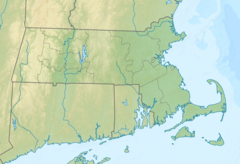Harvard Bridge
| Harvard Bridge | |
|---|---|

Harvard Bridge seen from Cambridge
|
|
| Coordinates | 42°21′16″N 71°05′29″W / 42.35457°N 71.09132°WCoordinates: 42°21′16″N 71°05′29″W / 42.35457°N 71.09132°W |
| Carries |
|
| Crosses | Charles River |
| Locale | Boston, Massachusetts to Cambridge, Massachusetts, United States |
| Maintained by | Massachusetts Department of Transportation (MassDOT) |
| ID number | B160124EYDOTNBI |
| Characteristics | |
| Design | haunched girder bridge |
| Material | steel |
| Total length | 659.82 meters (2,164.8 ft; 387.72 sm) (roadway) 364.4 smoots ± one ear (620 m) (sidewalk from Storrow Drive to Cambridge only) |
| Width | 21.13 meters (69.3 ft; 12.42 sm) (total width) 15.8 meters (52 ft; 9.3 sm) (roadway) |
| No. of spans | 25 |
| Piers in water | 24 |
| Load limit | 78.4 metric tons (86.4 short tons) |
| Clearance below | 3.7 meters (12 ft; 2.2 sm) |
| History | |
| Construction begin | 1887 |
| Construction end | 1891 |
| Opened | 1891-09-01, 1990 |
| Closed | 1983 (temporary closure for repairs) |
| Statistics | |
| Daily traffic | 49,000 as of 2005 |
The Harvard Bridge (also known locally as the MIT Bridge, the Massachusetts Avenue Bridge, and the "Mass. Ave." Bridge) is a steel haunched girder bridge between Back Bay, Boston and Cambridge, Massachusetts, United States, carrying Massachusetts Avenue (Route 2A) over the Charles River. It is the longest bridge over the Charles River at 659.82 meters (2,164.8 ft; 387.72 sm). It is locally known for being measured, inaccurately, in the idiosyncratic unit of length called the smoot.
After several legislative attempts fraught with antipathy on the part of Boston, it was built jointly by Boston and Cambridge, Massachusetts, between 1887 and 1891. It originally included a swing span. The bridge was revised over the years until its superstructure was completely replaced in the late 1980s due to unacceptable vibration and the collapse of a similar bridge. The bridge was named for the Reverend John Harvard.
In the Acts of 1874, the Massachusetts Legislature passed Chapters 175 and 314 to authorize the construction of a bridge between Boston and Cambridge. Nothing further happened until 1882, when a follow-up law, Acts of 1882, Chapter 155, with more specifics was enacted. The location was expressed as
Acts of 1882, Chapter 155, Section 1: The cities of Boston and Cambridge are authorized to construct a bridge and avenue across Charles river, from a point on Beacon street, in Boston, to a point in Cambridge, west of the westerly line of the Boston and Albany railroad. ... to the limitation that the line thereof shall not be north-east of a line drawn from the junction of Beacon street and West Chester park, in Boston, to the junction of the harbor line with Front Street, extended, in Cambridge, nor south-west of a line drawn from the junction of Beacon street, Brookline avenue and Brighton avenue, in Boston, to the junction of the Boston and Albany railroad with Putnam avenue, extended, in Cambridge.
...
Wikipedia

